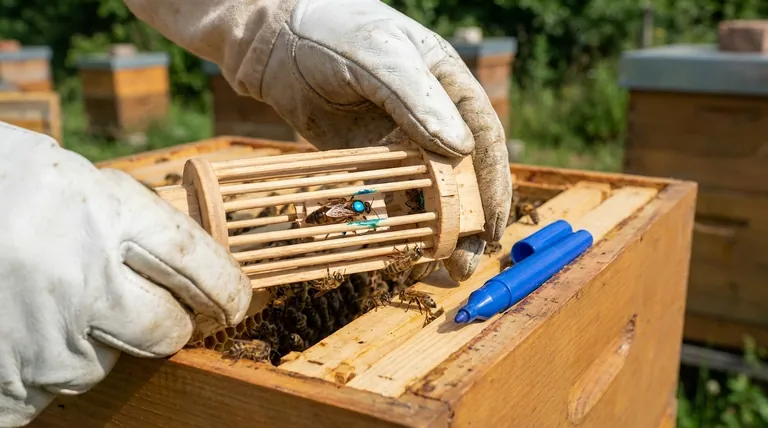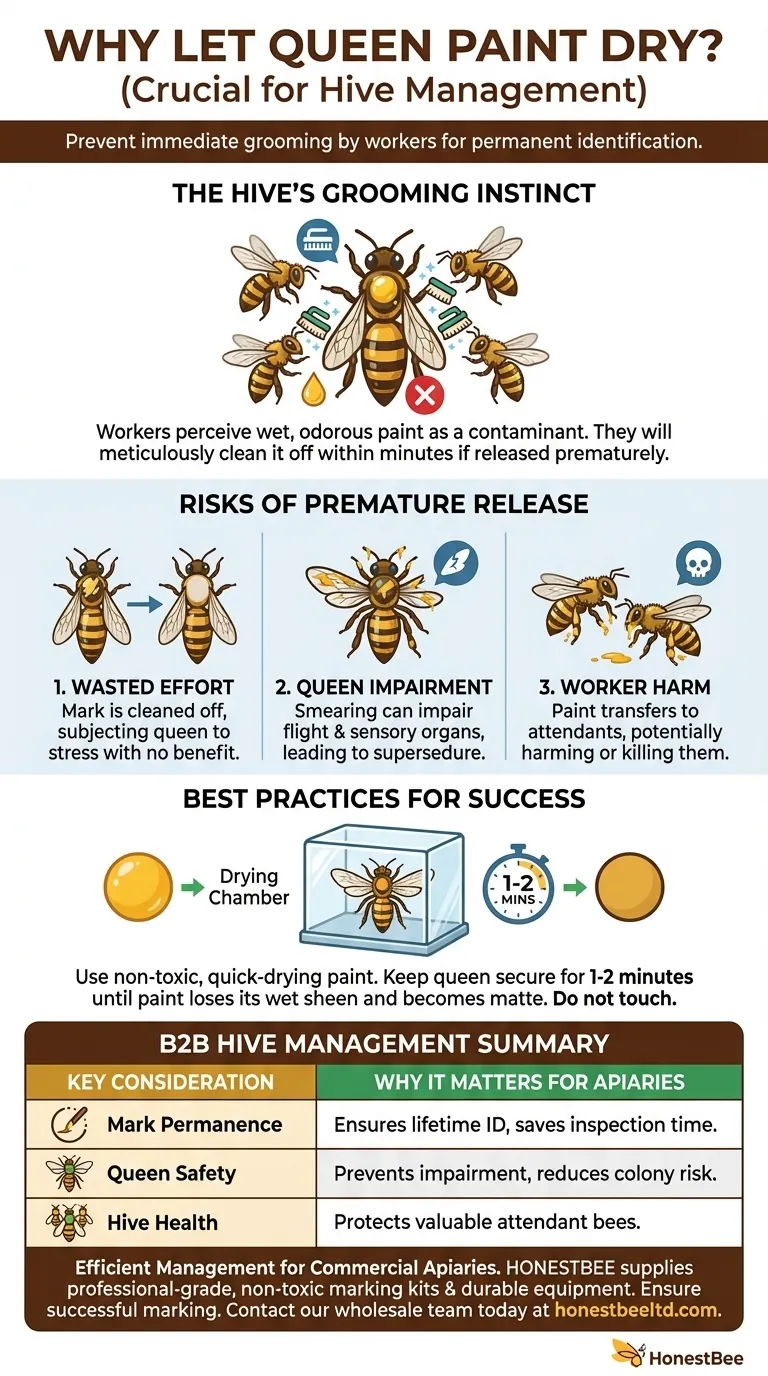The primary reason to let the paint dry on a queen bee before releasing her is to prevent her attendant worker bees from immediately cleaning it off. This simple act of patience ensures the mark is permanent, allowing you to easily identify her for the rest of her life.
The core issue is not the paint itself, but the natural grooming instinct of the hive. Wet paint is treated as a foreign contaminant, and if the queen is released prematurely, your marking efforts will be undone by her diligent caretakers within minutes.

The Hive's Cleaning Instinct
The success of queen marking hinges on understanding a fundamental aspect of honey bee behavior: their meticulous hygiene. A queen is constantly surrounded by a retinue of attendant workers who groom, feed, and care for her.
Why Worker Bees Clean the Queen
Grooming is a critical task for the attendant bees. They keep the queen clean and free of debris, ensuring she remains healthy and can effectively lay eggs.
Any foreign substance on the queen's body will trigger this grooming instinct.
Wet Paint is a Target
Worker bees perceive wet, odorous paint as a contaminant that must be removed. They will meticulously work to clean it off the queen's thorax, piece by piece.
If the paint has not had a chance to fully dry and harden, their efforts will be successful, and your mark will be gone.
The Consequence: A Wasted Effort
The entire purpose of marking a queen is to make her easily identifiable for future hive inspections. If the mark is cleaned off, you have subjected the queen to the stress of being caught and handled for no benefit.
Beyond Longevity: The Safety Risks of Wet Paint
While the primary concern is the durability of the mark, releasing a queen with wet paint introduces other, more serious risks to the colony's health.
The Danger of Smearing
A queen with wet paint on her thorax can easily smear it. The paint can get on her wings, preventing flight, or on her antennae, which are critical sensory organs.
This impairment can reduce her effectiveness and may even lead to the colony superseding (replacing) her.
Transferring Paint to Other Bees
As the worker bees attempt to clean the wet paint off the queen, it will inevitably get on them. This can gum up their own body parts, potentially harming or killing the very bees tasked with caring for the queen.
Best Practices for a Successful Marking
Ensuring the mark is both safe and permanent requires a patient and deliberate technique. The goal is to allow the paint to become completely non-tacky before the queen is returned to the workers.
Use the Right Tool
Queen marking pens or specific enamel paints are designed to be non-toxic and quick-drying. Avoid using standard paints that may contain harmful chemicals.
Create a "Drying Chamber"
After applying a small dot of paint to her thorax, keep the queen gently secured in your marking cage or tube for a minute or two. This gives the paint ample time to dry without her being able to smear it or other bees trying to remove it.
The Touch Test is Unnecessary
You can typically see when the paint loses its wet sheen and becomes matte. This is a good indicator that it is dry enough for release. Avoid touching it, as this can damage the mark.
Applying This to Your Beekeeping
Your approach to releasing the queen should be guided by the dual goals of safety and permanence.
- If your primary focus is mark longevity: Ensure the paint has completely lost its wet gloss and appears dull. This usually takes 1-2 minutes and guarantees the mark has cured enough to resist cleaning.
- If your primary focus is minimizing stress on the queen: Hold her in the marking tube just long enough for the paint to become tack-free, then gently release her onto a frame away from the main cluster to let her reacclimate calmly.
Ultimately, taking an extra minute to ensure the paint is dry protects the queen's health and preserves the value of your work.
Summary Table:
| Key Consideration | Why It Matters |
|---|---|
| Mark Permanence | Dry paint resists the natural grooming instinct of attendant worker bees, ensuring the identification mark lasts the queen's lifetime. |
| Queen Safety | Wet paint can smear, impairing the queen's wings or antennae, which may lead to her being superseded by the colony. |
| Hive Health | Prevents paint from being transferred to and harming worker bees during grooming, protecting the colony's caretakers. |
| Best Practice | A 1-2 minute drying time in a secure marking cage is sufficient for the paint to cure and become safe for release. |
For commercial apiaries and distributors, efficient hive management is critical. Properly marked queens save valuable inspection time and support colony health. HONESTBEE supplies professional-grade, non-toxic queen marking kits and durable beekeeping equipment designed for high-volume operations. Ensure your marking efforts are successful and your equipment is reliable—contact our wholesale team today to discuss your needs.
Visual Guide

Related Products
- Queen Bee Marking Pen UNI Medium Point for Queen and Bee Marking
- Queen Bee Marking Pen POSCA Queen Marking Pens for Beekeeping Bee Markers
- Professional Engraved Round Hive Number Tags for Beekeeping
- Plastic Queen Marking Tube Cage with Plunger for Beekeeping
- Heavy Duty Stainless Steel Queen Bee Catcher Clip
People Also Ask
- What are the advantages of using Uni-Posca markers for Queen marking? A Safe, Precise, and Efficient Solution
- What are the characteristics of Posca pens for marking queens? A Safe, Durable Solution for Hive Management
- What are the color codes in the queen-marking system? Master Hive Management with the 5-Year Cycle
- Why is marking a Queen bee important for beekeepers? Elevate Your Apiary Management
- How should a Posca pen be prepared for queen marking? Ensure a Safe, Precise Mark Every Time



















